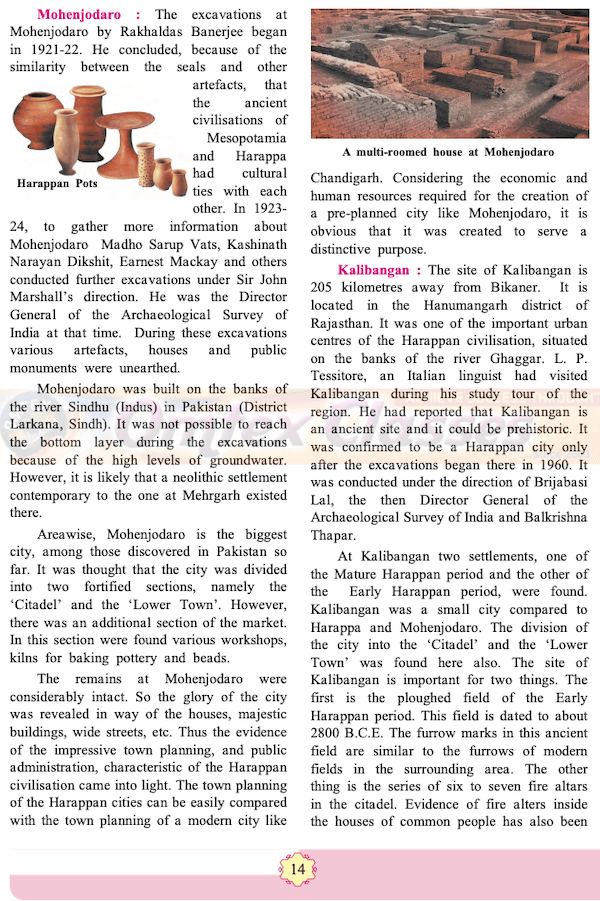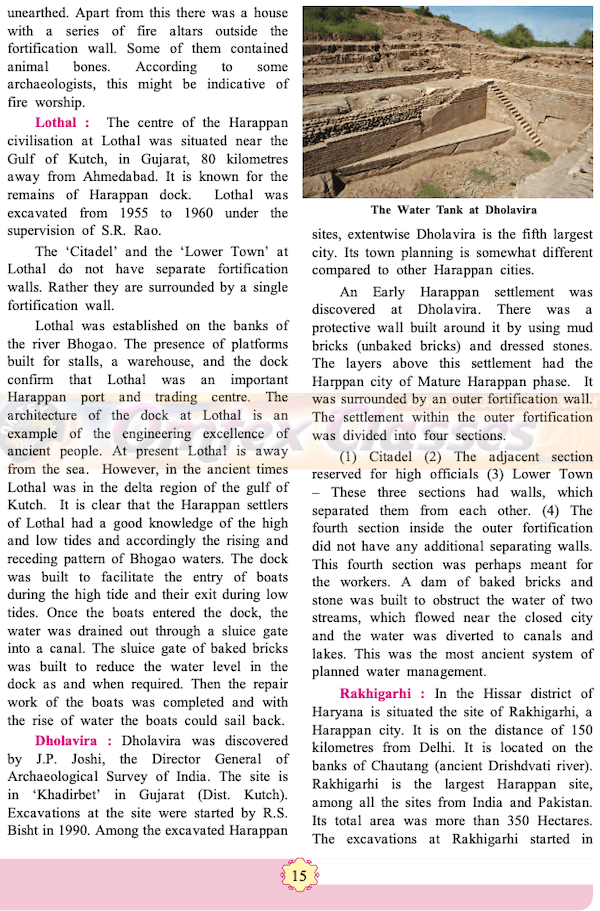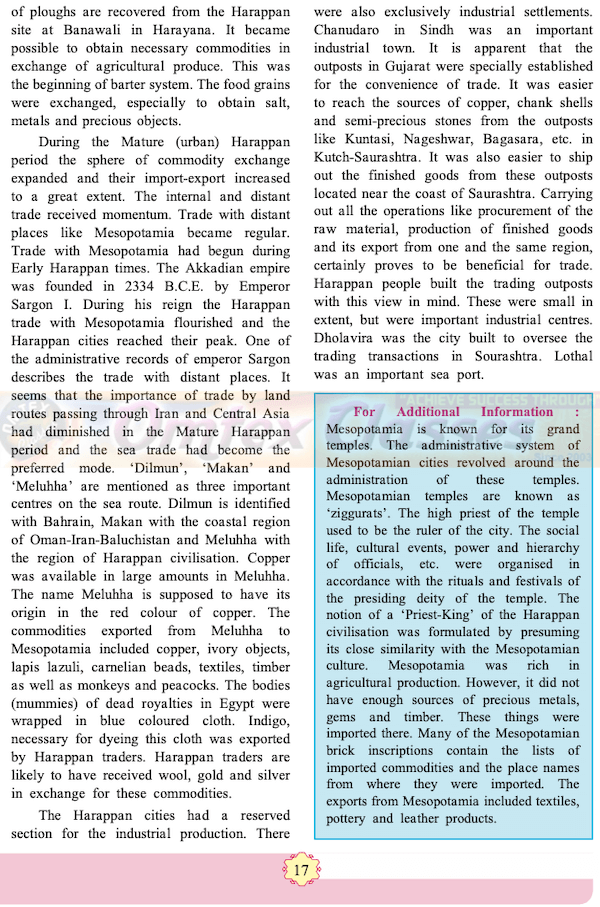Chapter 2: First Cities of India
Choose the correct alternative and write the complete sentence.
In the early phase of agriculture, making ______ pots and farming were the jobs of women.
OPTIONS
copper
bronze
earthen
stone
Lothal is known for its ancient ______.
OPTIONS
agriculture
dock
textiles
tools
A general impression prevailed that the Harappan seals had some connection with the ______ civilisation.
OPTIONS
Chinese
Greek
Mesopotamian
Egyptian
The bodies (mummies) of dead royalties in Egypt were wrapped in ______ coloured cloth.
OPTIONS
white
black
red
blue
The major reason for the decline of the Mesopotamian civilisation was -
OPTIONS
foreign invasion
deteriorating environment
loss in trade
migration
Find the incorrect pair from Set B and write the correct ones.
SOLUTION
Explain the statement with reasons.
The remains found at cities like Harappa, Mohenjodaro, Kalibangan, Lothal, Dholavira, Rakhigarhi, etc. are the evidence of the past glory of Harappan civilisation.
SOLUTION
A well-developed and rich civilisation flourished in the Indian subcontinent in the period from 3500-3000 B.C.E.
This period is characterised by systematic town planning, with houses of baked brick, granaries, excellent drainage systems, public baths, and impressive public movements.
Good administrative control over the distribution of water and other resources.
Remains also prove a good social organisation, a proper social hierarchy based on the position of power.
Flourishing internal and distant trade, mass production of goods and craft specialisation developed writing system of script on Harappan seals give evidence of the past glory of the civilisation.
Lapis lazuli had a very important place in the Harappan trade.
SOLUTION
A network of small towns, big and small villages, and campsites of semi-nomadic people functioned to cater to the needs of major urban centres of the Harappan civilisation.
The Harappan settlement of 'Shortugai' in the Badakshan province of Afghanistan, is rich with mines of lapis lazuli, a semi-precious stone in Mesopotamia.
The Mesopotamian epics describe Goddess Inanna's palace, the walls of which were embedded with this stone, lapis lazuli.
This stone was a very important commodity in the Harappan trade with Mesopotamia.
Harappan civilisation declined.
SOLUTION
Sir Mortimer Wheeler in his study has concluded that Harappan civilisation was destroyed by Indra, who destroyed the fortified cities.
Vedic Aryans destroyed the Harappan cities under the leadership of Indra.
The civilisation also declined due to the cumulative effects of factors such as a decline in trade, climatic changes, and weakening of the economy.
State your opinion.
The Harappan cities and villages in the vicinity were interdependent.
SOLUTION
The interrelationship between Harappan cities and villages was dependent on the mechanism of making available food grains and raw materials.
A network of small towns, big and small villages and camp sites of semi-nomadic people, functioned to cater to the needs of major urban centres of Harappan civilisation.
The city people were dependent on natural sources and villages in their vicinity, to meet the needs of urban lifestyle and urban administration.
The Harappan cities seem to have a well-organised administrative system.
SOLUTION
The Harappan cities had a well organised administrative system to manage industrial production, import-export, the interrelationship between cities managing trading operations and villages around them.
The town planning, standardisation of bricks, weights, seals, shapes, and ornamentation of various objects, confirm the presence of an efficient administrative system.
Cities like Harappa and Mohenjodaro were perhaps regional capitals.
Lothal and Kalibangan were important religious centres,
However, the nature of Harappan polity, whether it was a single state or a federation of small states, is not yet known.
Answer the following question with the help of given points.
Write about the characteristics of Harappan cities with the help of given points.
Town planning
Social organisation
Administration
Economy
SOLUTION
(a) Town planning :
The town planning of Harappan cities was very systematic.
Houses were of baked bricks, which included bathrooms, toilets, wells.
Granaries existed, with impressive public monuments.
The excellent drainage system, public baths, and independent fortification walls are highlights.
The grid pattern was used, where streets crossed each other in right angles, and the resulted blocks were used for building houses.
The English bond masonry method was used with two headers and two stretchers to build a wall, which was especially useful for earthquake-prone areas.
(b) Social organisation:
Social hierarchy was based on the position of power.
Classes of skilled artisans and individuals were based on craft specialisation.
Belief systems existed, with evidence of burials indicating rituals after death.
Artifacts and architecture also indicate belief systems.
(c) Administration:
Administrative control existed over the distribution of water and other resources.
The size of bricks indicates the use of standardisation and ratio.
Weights set the style of shapes and painted designs of pottery, majestic, and non-residential buildings for public administrative offices are also seen.
(d) Economy :
Harappan civilisation practised mass production of goods for trade purposes.
The concentration of factories and residences of artisans in a particular area of the city indicates the purpose of convenience of production, flourishing internal and distant trade, and administrative control over trade transactions.
Well-shaped, beautiful earthen pots, statues, metal objects of gold, silver, copper, and bronze were made.
Various types of beads were prepared, indicating a sound economy.
Balbharati Solutions for History 11th Standard Maharashtra State Board
• Chapter 2: First Cities of India
• Chapter 3: Chalcolithic Villages in India
• Chapter 5: Janapadas and Republics
• Chapter 6: Second Urbanisation in India
• Chapter 7: India and Iran (Persia)
• Chapter 8: India during Mauryan period
• Chapter 9: Post Mauryan India
• Chapter 11: Kingdoms in South India
• Chapter 12: India, Nations in the northwest of the Indian Subcontinent and China
• Chapter 13: India, Shri Lanka and Southeast Asia
• Chapter 14: Delhi Sultanate, Vijayanagar and Bahamani Kingdom
• Chapter 15: India during Mughal period
• Chapter 16: Swarajya to Empire (Maratha period)
.











